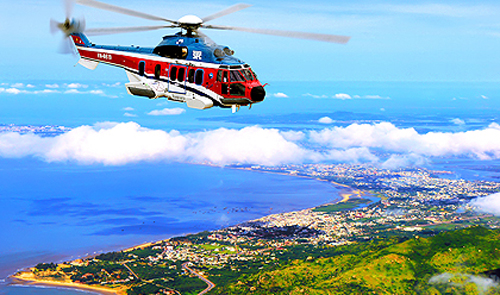To guard airspace and territorial waters, pilots of squadron EC-225 under the Naval Operations Staff of the Vietnam Navy have kept on training a routine flight program with state-of-the-art aircraft.
Responsible for key missions of scouting and search and rescue at sea, the powerful and fast 11-ton-class EC-225 helicopter combines long-range performance with a very large cabin – accommodating up to 19 passengers in crashworthy seats.
With a service flight ceiling of 5.9km and a max weight of 24,251 lbs, an EC-225 can accommodate two pilots and 19 passengers and operate at a maximum speed of 275.5 kph.
Its integrated display system, advanced avionics and digital 4-axis automatic pilot significantly reduces flight crew workload, improves mission effectiveness and increases operational safety.
Tuoi Tre journalists accompanied a regular patrol flight along the coast of Vietnam and witnessed a training day of the squadron’s pilots with the five-bladed-rotor helicopters.
A training session
The cockpit of an EC-225 aircraft on the training day included three men – main pilot Nghiem Quang Huy, pilot Tran Hoai Nam and flight trainer Kieu Dang Hung.
Huy reported the ready status of his machine and crew with a verbal command to air traffic control, “VNT EC-225, Check good, Take-off.” After being informed of the wind speed, air pressure and temperature at the airfield by the control unit, the chief pilot was allowed to ‘take-off’.
The helicopter, the latest member of the French-made Eurocopter Super Puma family, began lifting up from the ground for a training session.
The content of the crew was to ensure operations in emergency situations when one of the two engines broken down at sea and safely pilot it back to a nearby army base, landing with air cushion trouble, plane’s failure of hydraulic power system, and operating from a very small helipad at sea or on shore.
On this day, pilots Huy and Nam took turns operating the controls as part of their training. When one of them sat in the driving seat, the other kept his eyes on a check list, which is a mandatory procedure for the complete inspection and control of the aircraft.
Other exercises during the training included flying in a circle above the airfield, and forcing the helicopter to bank left and right in a simulation of losing balance. Pilots are also required to react to applications of their controls and other aircraft systems and to external environmental factors such as air density, turbulence, clouds, and precipitation as demanded by the trainer.
The most complicated situation presented by the training plan is the one in which the craft loses its lifting power from an air cushion while hovering at a height of over 40m, and descends on a 15 degree incline until gaining the necessary speed (VTOSS) for taking off again.
“I got a little confused with the situation,” pilot Tran Hoai Nam admitted.
After three hours in the sky, the training session ended at 4:30pm with a total of 31 lift-offs and landings. The EC-225 was then transferred to a technical unit for maintenance in a hangar.
The target of the session was not only to help pilots gain precise handling but also remain calm in the sky, especially in an emergency.
Hard learning
“I felt embarrassed when I was sitting in the driving seat facing the automatic flight control panel,” Huy admitted. “It’s so modern and complicated.”
“It has a digital engine control unit, a duplicate integrated flight display system, and piloting and navigation and mission multifunction to ensure effective operations in bad weather,” he said.
Airmen like Huy and Nam had to pass strict training abroad and in Vietnam before becoming part of the squadron. They were recruited from the ranks experienced combat pilots, and spent 18 months studying English before being sent to France for two months of pilot training.
To pilot the state-of-the-art craft, they had to spend time training in a simulator – an exact replica of the helicopter cockpit – in order to become familiar with the controls and systems of the aircraft. Trainees can experience real-world reactions in response to pilot control movements and external aerodynamic factors, such as the feeling of descending and air sickness.
Any imprecise handling in the simulator will be displayed on visual systems so that trainees can repeat the process.
“We EC-225 pilots always mutter something as our mind is calculating and imagining that we are at work in the cockpit and falling in a supposed emergency,” Huy said.
Huy also mentioned the logistics personnel who make silent but valuable contributions to each operation and training flight. The technical officials are the ones who come early and go home late.
Vu Dinh Ba, vice chief of a technical unit, said, “Our squadron has recently been set up and my staff is still learning during their work. Many of them stay up late reading documents until 11 or 12 at night. But having the chance to work with an EC-225 is our pride.”
The library of the squadron has over 100 thick books written in English featuring technical details of the EC-225. Technical staff members have spent months abroad and in Vietnam studying English.






















































